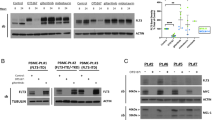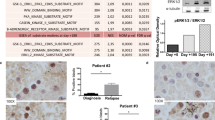Abstract
Somatic mutation of the FLT3 gene, in which the juxtamembrane domain has an internal tandem duplication, is found in 20% of human acute myeloid leukemias and causes constitutive tyrosine phosphorylation of the products. In this study, we observed that the transfection of mutant FLT3 gene into an IL3-dependent murine cell line, 32D, abrogated the IL3-dependency. Subcutaneous injection of the transformed 32D cells caused leukemia in addition to subcutaneous tumors in C3H/HeJ mice. To develop a FLT3-targeted therapy, we examined tyrosine kinase inhibitors for in vitro growth suppression of the transformed 32D cells. A tyrosine kinase inhibitor, herbimycin A, remarkably inhibited the growth of the transformed 32D cells at 0.1 μM, at which concentration it was ineffective in parental 32D cells. Herbimycin A suppressed the constitutive tyrosine phosphorylation of the mutant FLT3 but not the phosphorylation of the ligand-stimulated wild-type FLT3. In mice transplanted with the transformed 32D cells, the administration of herbimycin A prolonged the latency of disease or completely prevented leukemia, depending on the number of cells inoculated and schedule of drug administration. These results suggest that mutant FLT3 is a promising target for tyrosine kinase inhibitors in the treatment of leukemia.
This is a preview of subscription content, access via your institution
Access options
Subscribe to this journal
Receive 12 print issues and online access
$259.00 per year
only $21.58 per issue
Buy this article
- Purchase on Springer Link
- Instant access to full article PDF
Prices may be subject to local taxes which are calculated during checkout




Similar content being viewed by others
References
Furitsu T, Tsujimura T, Tono T, Ikeda H, Kitayama H, Koshimizu U, Sugahara H, Butterfield JH, Ashman LK, Kanayama Y, Matsuzawa Y, Kitamura Y, Kanakura Y . Identification of mutations in the coding sequence of the proto-oncogene c-kit in a human mast cell leukemia cell line causing ligand-independent activation of c-kit product J Clin Invest 1993 92: 1736–1744
Golub TR, Barker GF, Lovett M, Gilliland DG . Fusion of PDGF receptor beta to a novel ets-like gene, tel, in chronic myelomonocytic leukemia with t(5;12) chromosomal translocation Cell 1994 77: 307–316
Nakao H, Yokota S, Iwai T, Kaneko H, Horiike S, Kashima K, Sonoda Y, Fujimoto T, Misawa S . Internal tandem duplication of the flt3 gene found in acute myeloid leukemia Leukemia 1996 10: 1911–1918
Yokota S, Kiyoi H, Nakao M, Iwai T, Misawa S, Okuda T, Sonoda Y, Abe T, Kashima K, Matsuo Y, Naoe T . Internal tandem duplication of the FLT3 gene is preferentially seen in acute myeloid leukemia and myelodysplastic syndrome among various hematological malignancies. A study on a large series of patients and cell lines Leukemia 1997 11: 1605–1609
Kiyoi H, Naoe T, Yokota S, Nakao M, Minami S, Kuriyama K, Takeshita A, Saito K, Hasegawa S, Shimodaira S, Tamura J, Shimazaki C, Matsue K, Kobayashi H, Arima N, Suzuki R, Morishita H, Saito H, Ueda R, Ohno R, the Leukemia Study Group of the Ministry of Health and Welfare (Kohseisho) . Internal tandem duplication of FLT3 associated with leukocytosis in acute promyelocytic leukemia Leukemia 1997 11: 1447–1452
Kiyoi H, Naoe T, Nakano Y, Yokota S, Minami S, Miyawaki S, Asou N, Kuriyama K, Jinnai I, Shimazaki C, Akiyama H, Saito K, Oh H, Motoji T, Omoto E, Saito H, Ohno R, Ueda R . Prognostic implication of FLT3 and N-RAS gene mutations in acute myeloid leukemia Blood 1999 93: 3074–3080
Horiike S, Yokota S, Nakao M, Iwai T, Sasai Y, Kaneko H, Taniwaki M, Kashima K, Fujii H, Abe T, Misawa S . Tandem duplications of the FLT3 receptor gene are associated with leukemic transformation of myelodysplasia Leukemia 1997 11: 1442–1446
Nakano Y, Kiyoi H, Miyawaki S, Asou N, Ohno R, Saito H, Naoe T . Molecular evolution of acute myeloid leukaemia in relapse: unstable N-ras and FLT3 genes compared with p53 gene Br J Haematol 1999 104: 659–664
Rosnet O, Schiff C, Pebusque MJ, Marchetto S, Tonnelle C, Toiron Y, Birg F, Birnbaum D . Human FLT3/FLK2 gene: cDNA cloning and expression in hematopoietic cells Blood 1993 82: 1110–1119
Lyman S, Jacobsen S . c-kit ligand and Flt3 ligand: stem/progenitor cell factors with overlapping yet distinct activities Blood 1998 91: 1101–1134
Drexler HG . Expression of FLT3 receptor and response to FLT3 ligand by leukemic cells Leukemia 1996 10: 588–599
Lisovsky M, Estrov Z, Zhang X, Consoli U, Sanchez-Williams G, Snell V, Munker R, Goodacre A, Savchenko V, Andreeff M . Flt3 ligand stimulates proliferation and inhibits apoptosis of acute myeloid leukemia cells: regulation of Bcl-2 and Bax Blood 1996 88: 3987–3997
Kiyoi H, Towatari M, Yokota S, Hamaguchi M, Ohno R, Saito H, Naoe T . Internal tandem duplication of the FLT3 gene is a novel modality of elongation mutation which causes constitutive activation of the product Leukemia 1998 12: 1333–1337
Tsujimura T, Morimoto M, Hashimoto K, Moriyama Y, Kitayama H, Matsuzawa Y, Kitamura Y, Kanakura Y . Constitutive activation of c-kit in FMA3 murine mastcytoma cells caused by deletion of seven amino acids at the juxtamembrane domain Blood 1996 87: 273–283
Levitzki A, Gazit A . Tyrosine kinase inhibition: an approach to drug development Science 1995 267: 1782–1788
Okabe M, Uehara Y, Miyagishima T, Itaya T, Tanaka M, Kuni-Eda Y, Kurosawa M, Miyazaki T . Effect of herbimycin A, an antagonist of tyrosine kinase, on bcr/abl oncoprotein-associated cell proliferations: abrogative effect on the transformation of murine hematopoietic cells by transfection of a retroviral vector expressing oncoprotein P210bcr/abl and preferential inhibition on Ph1-positive leukemia cell growth Blood 1992 80: 1330–1338
Okabe M, Uehara Y, Noshima T, Itaya T, Kunieda Y, Kurosawa M . In vivo antitumor activity of herbimycin A, a tyrosine kinase inhibitor, targeted against BCR/ABL oncoprotein in mice bearing BCR/ABL-transfected cells Leukemia Res 1994 18: 867–873
Honma Y, Matsuo Y, Hayashi Y, Omura S . Treatment of Philadelphia-chromosome-positive human leukemia in SCID mouse model with herbimycin A, bcr-abl tyrosine kinase activity inhibitor Int J Cancer 1995 60: 685–688
le Coutre P, Mologni L, Cleris L, Marchesi E, Buchdunger E, Giardini R, Formelli F, Gambacorti-Passerini C . In vivo eradication of human BCR/ABL-positive leukemia cells with an ABL kinase inhibitor J Natl Cancer Inst 1999 91: 163–168
Umezawa H, Imoto M, Sawa T, Isshiki K, Matsuda N, Uchida T, linuma H, Hamada M, Takeuchi T . Studies on a new epidermal growth factor-receptor kinase inhibitor, erbstatin, produced by MH435-hF3 J Antibiot 1986 39: 170–173
Ogawara H, Akiyama T, Ishida J, Watanabe S, Suzuki K . A specific inhibitor for tyrosine protein kinase from Pseudomonas J Antibiot 1986 39: 606–608
Levitzki A, Gilon C . Tyrphostins as molecular tools and potential antiproliferative drugs Trends Pharmacol Sci 1991 12: 171–174
Uehara Y, Hori M, Takeuchi T, Umezawa H . Screening of agents which convert ‘transformed morphology’ of Rous sarcoma virus-infected rat kidney cells to ‘normal morphology’: identification of an active agent as herbimycin and its inhibition of intracellular src kinase Jpn J Cancer Res 1985 76: 672–675
Uehara Y, Murakami Y, Sugimoto Y, Mizuno S . Mechanism of reversion of Rous sarcoma virus transformation by herbimycin A: reduction of total phosphotyrosine levels due to reduced kinase activity and increased turnover of p60v-src1 Cancer Res 1989 49: 780–785
Uehara Y, Murakami Y, Mizuno S, Kawai S . Inhibition of transforming activity of tyrosine kinase oncogenes by herbimycin A Virology 1988 164: 294–298
Murakami Y, Fukazawa H, Mizuno S, Uehara Y . Effect of herbimycin A on tyrosine kinase receptors and platelet derived growth factor (PDGF)-induced signal transduction Biol Pharm Bull 1998 21: 1030–1035
Dosil M, Wang S, Lemischka IR . Mitogenic signalling and substrate specificity of the Flk2/Flt3 receptor tyrosine kinase in fibroblasts and interleukin 3-dependent hematopoietic cells Mol Cell Biol 1993 13: 6572–6585
Zhang S, Mantel C, Broxmeyer HE . Flt3 signaling involves tyrosyl-phosphorylation of SHP-2 and SHIP and their association with Grb2 and Shc in Baf3/Flt3 cells J Leuk Biol 1999 65: 372–380
Mori S, Ronnstrand L, Yokote K, Engstrom A, Courtneidge SA, Claesson-Welsh L, Heldin CH . Identification of two juxtamembrane autophosphorylation sites in the PDGF beta-receptor; involvement in the interaction with Src family tyrosine kinases EMBO J 1993 12: 2257–2264
Riordan FA, Bravery CA, Mengubas K, Ray N, Borthwick NJ, Akbar AN, Hart SM, Hoffbrand AV, Mehta AB, Wickremasinghe RG . Herbimycin A accelerates the induction of apoptosis following etoposide treatment or gamma-irradiation of bcr/abl-positive leukaemia cells Oncogene 1998 16: 1533–1542
Acknowledgements
We thank Chisato Kamiya, Yoko Kudo and Yoko Tagawa for their technical assistance, and Kirin Brewery Company Ltd for providing murine IL3.
Author information
Authors and Affiliations
Rights and permissions
About this article
Cite this article
Zhao, M., Kiyoi, H., Yamamoto, Y. et al. In vivo treatment of mutant FLT3-transformed murine leukemia with a tyrosine kinase inhibitor. Leukemia 14, 374–378 (2000). https://doi.org/10.1038/sj.leu.2401680
Received:
Accepted:
Published:
Issue Date:
DOI: https://doi.org/10.1038/sj.leu.2401680



